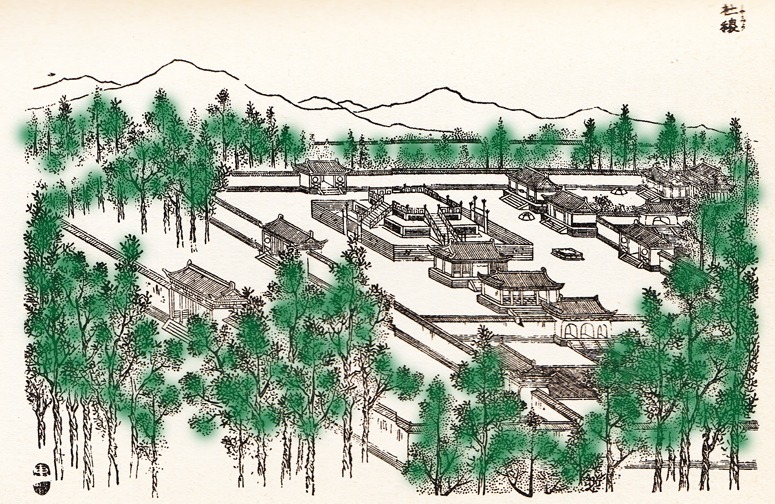
The Altar of Land and Grain (now Zhongshan Park or the Sun Yat-Sen Memorial Park in Bejing) had what western historians call a 'formal' layout. It is neither the garden type nor the design style which features in histories of 'the' Chinese Garden.
There is a regrettable tendency for garden historians to write about the Chinese Garden as though it were one thing which was invented about 5000 years ago, which was made for a single purpose and which has never changed. It puts one in mind of Edward Said’s comment on Orientalism (regarding the Middle East). He wrote of “a misrepresentation of some Oriental essence — in which I do not for a moment believe”. We are therefore pleased to publish a classification of Chinese garden types by Xiaomin Wu. The next stage in developing a systematic history of garden design in China should be to trace the evolution of each of these types through the millennia. This should be done in parallel with studies of the influence of Chinese gardens on neighbouring countries and the influence of neighbouring countries on China. One of the many neglected aspects of Chinese garden history concerns the influence of Buddhism. Maggie Keswick, who wrote by far the most influential western book on Chinese garden history, scarcely mentions the subject.
Another puzzling aspect of Chinese garden history is that it is normally studied without reference to Japan or Korea. To me, this is like writing compartmentalised histories of French and Italian gardens or of Italian and English gardens. It should not be done. With regard to China, Japan, India and Korea, part of the explanation is that the countries were not friendly during the twentieth century – American garden historians have considered the influence of Chinese on Japanese gardens, but they have given far more attention to Japan than to China or India or Korea.
The Altar of Land and Grain (now Zhongshan Park and the Sun Yat-Sen Memorial in Bejing) (drawing above) had what western garden historians call a ‘formal’ layout’. It is neither ‘the’ garden type nor ‘the’ design style which features in histories of ‘the‘ Chinese Garden.

The drawing is very beautiful and reminds me very much of one of my favourite university design projects for a Buddhist temple complex. The architecture and landscape received equal design attention!
One would have to say that the influences on the layout of Altar of Land and Grain were Confucian and Daoist, but since neither of these faiths made temples before Buddhism reached China, you are surely right to see a Buddhist influence as well. Beliefs in East Asia occupy larger geographical areas than in West Asia but they are also related (as are Judaism, Islam, Christianity).
Well said and necessary. Much the same is true about the gardens of other nations. Then there’s the particular case of the Zen garden, which does not exist.
I accept Wybe Kuitert’s point that there is no mention of ‘Zen gardens’ in the literature of Japan before the 1930s, but do not think this is a reason for saying that Zen gardens do not exist. There was surely an association between gardens and Zen Buddhism so even if the attribution is retrospective I think ‘Zen Garden’ is a useful term. Equally, I think we could identify a Christian Garden, a Hindu Garden and perhaps even a Jewish Garden. Or, using Kuitert’s line of argument, one could go further and deny the existence of Medieval Gardens, Renaissance Gardens, Baroque Gardens, Landscape Gardens, Eclectic Gardens – and almost every other ‘type’ of garden. Ditto for Medieval, Baroque etc art and architecture!
Yes. It would be very interesting to know more about formative persons in Japanese garden design noted by Wybe Kuitert, for example Kobori Enshu, who “generally considered to be a kind of garden artist, was actually a high government official who directed the building and design of architecture and gardens.” (pxvii)
The first great ‘landscape architect’ known to history was also a priest: Senenmut. He was of course much else besides, and probably Hatshepsut’s lover.
Perhaps Hatshepsut, apart from being responsible for the building itself, was also responsible for the series of terraced gardens on the Djeser-Djeseru or “the Sublime of Sublimes”? [ http://www.travelegypt.com/peopleinfo/hatshepsut.htm ]
It is thought to have been joint project between Senenmut and Hapshepsut – but one can’t help thinking that the person with the technical skills (Senenmut) had a substantial influence on the outcome of the project.
Is this a comment on male/female relationships or client/patron relationships?
Both!
Hmmm. So if it was a project with Imhotep and Netjenkhet Djoser you would have made the same comment about Imhotep having a substantial influence on the outcome of the project?
I have no special knowledge of Hatshepsut and Senenmut’s sleeping arrangements but one often comes across the suggestion that they were rather close – and it is tempting to pass it on. Imhotep and Zoser, I have not come across any gosip.
I have no special knowledge of Hatshepsut and Senenmut’s sleeping arrangements but one often comes across the suggestion that they were rather close – and it is tempting to pass it on. Re Imhotep and Zoser, I have not come across any gosip.
Well perhaps Imhotep and Zoser would both be surprised to see this incarnation of their project? [ http://www.worldarchitecturenews.com/index.php?fuseaction=wanappln.projectview&upload_id=10224 ]